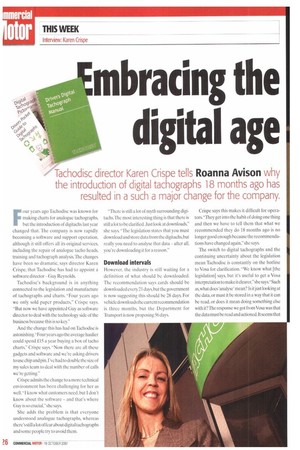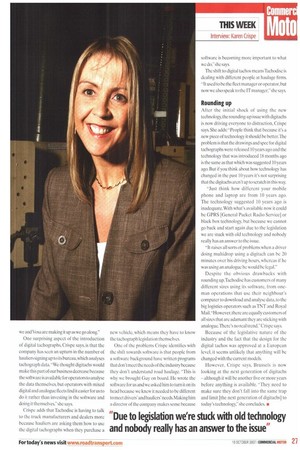Imbruing the digital age
Page 26

Page 27

If you've noticed an error in this article please click here to report it so we can fix it.
Tachodisc director Karen Crispe tells Roanna Avison why
the introduction of digital tachographs 18 months ago has
resulted in a such a major change for the company.
Four years ago Tachodisc was known for making charts for analogue tachographs, but the introduction of digitachs last year changed that. The company is now rapidly becoming a software and support operation. although it still offers all its original services, including the repair of analogue tacho heads, training and tachograph analysis. The changes have been so dramatic, says director Karen Crispe, that Tachodisc has had to appoint a software director G Lly Reynolds.
Tachodisc's background is in anything connected to the legislation and manufacture of tachographs and charts. "Four years ago we only sold paper products," Crispe says. "But now we have appointed Guy as software director to deal with the technology side of the business because this is so key."
And the change this has had on Tachodisc is astonishing. Four years ago the average haulier could spend £15 a year buying a box of tacho charts," Crispe says. "Now there are all these gadgets and software and we're asking drivers to use chip and pin. I've had to double the size of my sales team to deal with the number of calls we're getting."
Crispe admits the change to a more technical environment has been challenging for her as well." I know what customers need, but I don't know about the software and that's where Guy is so crucial," she says.
She adds the problem is that everyone understood analogue tachographs, whereas there's still a lot of fear about digital tachographs and some people try to avoid them. "There is still a lot of myth surrounding digitachs. The most interesting thing is that there is still a lot to be clarified. Just look at downloads," she says, -The legislation states that you must download and store data from the digitachs, but really you need to analyse that data after all, you're downloading it fora reason."
Download intervals
However, the industry is still waiting for a definition of what should be downloaded. The recommendation says cards should be downloaded every 21 days, but the government is now suggesting this should be 28 days. For vehicle downloads the current recommendation is three months, but the Department for Transport is now proposing 56 days, Crispe says this makes it difficult for operators. "They get into the habit of doing one thing and then we have to tell them that what we recommended they do 18 months ago is no longer good enough because the recommendations have changed again," she says.
The switch to digital tachographs and the continuing uncertainty about the legislation mean Tachodisc is constantly on the hotline to Vosa for clarification. "We know what [the legislation] says, but it's useful to get a Vosa interpretation to make it clearer," she says."Such as, what does 'analyse' mean? Is it just looking at the data, or must it be stored in a way that it can be read, or does it mean doing something else with it? The response we got from Vasa was that the data must be read and actioned. It seems that we and Vosa are making it up as we go along."
One surprising aspect of the introduction of digital tachographs, Crispe says, is that the company has seen an upturn in the number of hauliers signing up to its bureau,which analyses tachograph data, "We thought digitachs would make this part of our business decrease because the software is available for operators to analyse the data themselves, but operators with mixed digital and analogue fleets find it easier for us to do it rather than investing in the software and doing it themselves," she says.
Crispe adds that Tachodisc is having to talk to the truck manufacturers and dealers more because hauliers are asking them how to use the digital tachographs when they purchase a new vehicle, which means they have to know the tachograph legislation themselves.
One of the problems Crispe identifies with the shift towards software is that people from a software background have written programs that don't meet the needs of the industry because they don't understand road haulage. "This is why we brought Guy on board. He wrote the software for us and we asked him to turn it on its head because we knew it needed to be different to meet drivers' and hauliers' needs. Making him a director of the company makes sense because software is becoming more important to what we do," she says.
The shift to digital tachos means Tachodisc is dealing with different people at haulage firms. "It used to be the fleet manager or operator, but now we also speak to the IT manager," she says.
Rounding up After the initial shock of using the new technology,the rounding-up issue with digitachs is now driving everyone to distraction, Crispe says. She adds: "People think that because it's a new piece of technology it should be better. The problem is that the drawings and spec for digital tachographs were released 10 years ago and the technology that was introduced 18 months ago is the same as that which was suggested 10 years ago. But if you think about how technology has changed in the past 10 years it's not surprising that the digitachs aren't up to scratch in this way.
"Just think how different your mobile phone and laptop are from 10 years ago. The technology suggested 10 years ago is inadequate.With what's available now it could be GPRS [General Packet Radio Service] or black box technology, but because we cannot go back and start again due to the legislation we are stuck with old technology and nobody really has an answer to the issue.
"It raises all sorts of problems when a driver doing multidrop using a digitach can be 20 minutes over his driving hours, whereas if he was using an analogue he would be legal."
Despite the obvious drawbacks with rounding up,Tachodisc has customers of many different sizes using its software, from oneman operations that use their neighbour's computer to download and analyse data, to the big logistics operators such as TNT and Royal Mail."However, there are equally customers of all sizes that are adamant they are sticking with analogue.There's no real trend," Crispe says.
Because of the legislative nature of the industry and the fact that the design for the digital tachos was approved at a European level, it seems unlikely that anything will be changed with the current models.
However. Crispe says, Brussels is now looking at the next generation of digitachs — although it will be another five or more years before anything is available. "They need to make sure they don't fall into the same trap and limit [the next generation of digitachs] to today's technology,she concludes.






























































































































































































